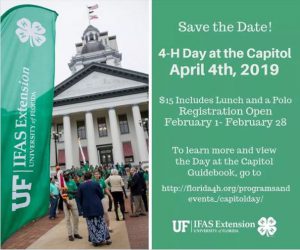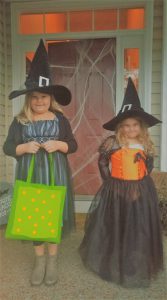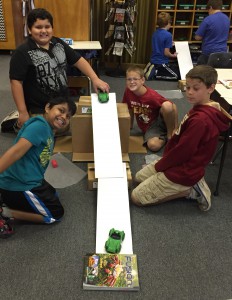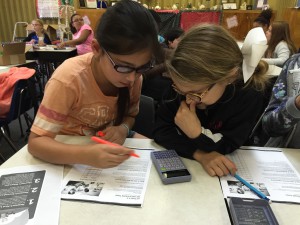by Taylor Wilken | Feb 1, 2019
 Last year, 520 youth and 170 adults from 34 Florida counties told the 4-H story filling the state capitol with 4-H advocates. Youth educated their representatives, senators, and legislative aides on how 4-H has made an impact in their lives while experiencing the political processes of state government.
Last year, 520 youth and 170 adults from 34 Florida counties told the 4-H story filling the state capitol with 4-H advocates. Youth educated their representatives, senators, and legislative aides on how 4-H has made an impact in their lives while experiencing the political processes of state government.
A sea of green will flood the Florida’s state capitol Thursday, April 4, 2019, as Florida 4-H members, faculty, volunteers, and families participate in the annual 4-H Day at the Capitol event.

2018 attendees on the steps of Florida’s historic capitol building.
4-H Day at the Capitol
- Who: All 4-H Members, Friends, Family and Alumni
- When: April 4, 2019
- Where: Tallahassee, FL
- Cost: $15 (includes lunch and a 4-H polo)
- Registration: February 1-28, 2019 in 4-H Online
Schedule
- 7:30-8:15am – Check-in
- 8:30am – Opening Assembly
- 9:00am – Group Photo
- 9:15am – Meetings with Representatives and Senators begins
- 12:00-1:00pm – Lunch Available for Pick-up (Chik-Fil-A)
- 1:00-1:30pm – Closing Assembly
Each county is encouraged to make appointments with senators and representatives and should schedule their day how it best suits the group. For detailed information on the schedule and to prepare for the event, be sure to read the The 4-H Day at the Capitol Guidebook.
Places to Visit/Things to do
Close to the Capitol, you’ll find several things to do to fill in the rest of your day.
- Governor’s Mansion
- Knott House
- Riley House and Museum
- 4-H Day at the Capitol Scavenger Hunt
- Florida Historic Capitol Museum
- Museum of Florida History
- Big Bend Farm
- For more information, check out Explore Tallahassee
Resources
For more information on 4-H Day at the Capitol or 4-H in your county, contact your local UF/IFAS County Extension Office.
by Melanie Taylor | Oct 31, 2017
From candy to pumpkins to the costumes, Halloween is a fun-filled time for kids and adults alike. However, it can pose dangers. To help make this year’s trick-or-treat a safe and fun time, follow these simple safety tips complied by the American Academy of Pediatrics.
CREATIVE COSTUMES:
Plan costumes that are bright and reflective. Make sure that shoes fit well and that costumes are short enough to prevent tripping, entanglement or contact with flames.
Consider adding reflective tape or striping to costumes and trick-or-treat bags for greater visibility.
Because masks can limit or block eyesight, consider non-toxic makeup and decorative hats as safer alternatives. Hats should fit properly to prevent them from sliding over eyes. The makeup should be tested ahead of time on a small patch of skin to ensure there are no unpleasant allergies on the big night.
When shopping for costumes, wigs and accessories look for and purchase those with a label clearly indicating they are “flame resistant”.
If a sword, cane, or stick is a part of your child’s costume, make sure it is not sharp or long. A child may be easily hurt by the accessories if he/she stumbles or trips.
Do not use decorative contact lenses without an eye examination and a prescription from an eye care professional. While the packaging on decorative lenses will often make claims such as “one size fits all,” or “no need to see an eye specialist,” obtaining decorative contact lenses without a prescription is both dangerous and illegal. This can cause pain, inflammation, and serious eye disorders and infections, which may lead to permanent vision loss.
Review with children how to call 911 if they ever have an emergency or become lost.
PUMPKIN CARVING TIME:
Small children should never carve pumpkins. Children can draw a face with markers. Then adults can do the cutting.
Consider using a flashlight or glow stick instead of a candle to light your pumpkin. If you do use a candle, a votive candle is safest.
Candlelit pumpkins should be placed on a sturdy table, away from curtains and other flammable objects, and not on a porch or any path where visitors may pass close by. They should never be left unattended.
HOME SAFETY:
To keep homes safe for visiting trick-or-treaters, parents should remove from the porch and front yard anything a child could trip over such as garden hoses, toys, bikes and lawn decorations.
Adults should check outdoor lights and replace burned-out bulbs.
Wet leaves and debris should be swept from sidewalks and steps.
Restrain pets so they do not jump on or bite a trick-or-treater.
TRICK-OR-TREAT TIME:
A responsible adult should always accompany young children during their neighborhood trick-or-treating.
Obtain flashlights with fresh batteries for all children and adults.
If your older children are going alone, plan and review the route that is acceptable to you. Agree on a specific time when they should return home.
Only go to homes with a porch light on and never enter a home or car for a treat.
Because pedestrian injuries are the most common injuries to children on Halloween, remind Trick-or-Treaters to:
- Stay in a group and communicate where they will be going.
- Remember reflective tape for costumes and trick-or-treat bags.
- Carry a cellphone for quick communication.
- Remain on well-lit streets and always use the sidewalk.
- If no sidewalk is available, walk at the far edge of the roadway facing traffic.
- Never cut across yards or use alleys.
- Only cross the street as a group in established crosswalks (as recognized by local custom). Never cross between parked cars or out driveways.
- Do not assume the right of way. Motorists may have a hard time seeing Trick-or-Treaters.
- Just because one car stops, does not mean others will!
- Law enforcement authorities should be notified immediately of any suspicious or unlawful activity
HEALTHY HALLOWEEN TIPS:
A good, healthy dinner prior to parties and trick-or-treating will discourage children from filling up on Halloween treats.
Consider purchasing non-food treats for those who visit your home, such as coloring books, stickers, or pens and pencils.
Wait until children are home to sort and check treats. Though tampering is rare, a responsible adult should closely examine all treats and throw away any spoiled, unwrapped or suspicious items.
Try to ration treats for the days and weeks following Halloween to prevent overindulging, which will lead to a stomachache and ruin the night’s fun.
Make sure the Halloween night is fun and safe with the suggested tips above. These tips will help guarantee you all a ghoulishly good time.
Source: American Academy of Pediatrics

Happy Halloween!
by Whitney Cherry | Apr 12, 2016

Students in Mrs. Peacocks 5th grade science class explored the Laws of Motion during 4-H National Science Day.
It’s day two of National Volunteer Week, and today our 4-H volunteer spotlight is on Mrs. Kim Peacock. Kim is a 5th grade science teacher at Blountstown Elementary School in Calhoun County. Recently I had the opportunity to chat with Kim about her experiences with 4-H in the classroom.
When I asked her what advice she has for someone who is thinking about becoming a 4-H volunteer, she responded, “I would definitely encourage them to do it. Especially teachers. If you can have 4-H programs in your classroom, you really should. It’s ok not to know anything about the topic going into it, because that’s what school is for – learning. And it’s ok to learn along with our students sometimes.
4-H has really made a difference in my students’ lives. We’ve done so many things. An Ag Adventures field trip where they learned about local ag commodities like corn, cotton, and peanuts; National Youth Science Day, where we built and launched rockets right there at school, and embryology projects where we learned about the embryonic development of baby chicks and hatched eggs in our classroom. I probably never would have done any of these things on my own, so first and foremost is the exposure to new and different things that I think makes a difference. But beyond that, I’ve seen my students gain confidence, show curiosity, and get truly excited about math and science without even realizing it.
These are the things they will remember when they leave school. These are experiences they will never forget, and if nothing else, it makes me feel good to know that despite what life may throw at them in the future they will always have these happy childhood memories to hold on to. Any opportunity that comes my way to add a 4-H project to my classroom in the future, I’m going to take it. It’s a no brainer. This is good stuff, and our kids deserve it.”
Although our traditional programs revolve around clubs, 4-H also offers opportunities for volunteers and teachers to provide 4-H opportunities in school settings both during and afterschool. These programs are a great way for youth to get a “taste of 4-H” before committing to longer term involvement in a club. 4-H Afterschool clubs also provide access to 4-H to youth who might not have transportation to evening or weekend club meetings. For more information about 4-H school programs, read this previous blogpost on 4-H Opportunities for Schools. If you are a teacher or community member that would like to make a difference at our local school, think about sharing your talents with us! You can fuel the extraordinary efforts of our youth by joining us as a volunteer. To find out more, contact your local UF IFAS Extension Office or visit http://florida4h.org/volunteers. Happy National Volunteer Appreciation Week!

4-H school programs include not only science, but public speaking, ag awareness, and even money management to help youth learn “soft skills” that employers seek.
 Last year, 520 youth and 170 adults from 34 Florida counties told the 4-H story filling the state capitol with 4-H advocates. Youth educated their representatives, senators, and legislative aides on how 4-H has made an impact in their lives while experiencing the political processes of state government.
Last year, 520 youth and 170 adults from 34 Florida counties told the 4-H story filling the state capitol with 4-H advocates. Youth educated their representatives, senators, and legislative aides on how 4-H has made an impact in their lives while experiencing the political processes of state government.



